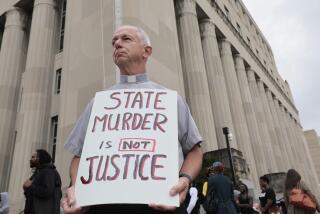Death Penalty: Blame Briggs, Not Court
Fifty-four death-penalty judgments have been reviewed with finality by the California Supreme Court since 1978. Half were cases tried under the 1977 death-penalty law sponsored by George Deukmejian, then a state senator. The other half were cases tried under the Briggs initiative passed by voters in 1978. A comparison of the two groups of cases reveals startling differences. Those who charge Supreme Court justices with carrying out a âhidden agendaâ to sabotage the death penalty are pointing in the wrong direction. The justices emerge as victims of a misguided zealot, former state Sen. John Briggs, whose handiwork will wreak havoc for years to come, regardless of who sits on the Supreme Court.
The 1977 Deukmejian law was carefully drafted to emulate the âguided discretionâ laws of Georgia, Florida and Texas, which had been upheld by the U.S. Supreme Court a year earlier. It required the jury to make three factual findings before a death penalty could be imposed: The defendant had to be convicted of first-degree murder, carrying a 25-years-to-life penalty; the jury had to find that there were carefully defined âspecial circumstances,â which increased the penalty to death or life without parole; finally, the jury had to choose between those two alternatives by weighing aggravating and mitigating circumstances.
A review of the Supreme Courtâs decisions under the 1977 law shows that conviction of first-degree murder was upheld in 59% of the cases, and the finding of special circumstances was upheld in 75%. As to the third choice, between death and life without parole, the court upheld the death judgment 25% of the time.
These affirmance rates can be compared to the courtâs affirmance rate in non-capital cases, which has ranged from 41% to 69% in recent years, and to the affirmance rate for death-penalty cases in other states. The Florida Supreme Court, for example, upheld 51% of the death-penalty cases that it reviewed. If Californiaâs 1977 law had been left intact, there is no question that many more death sentences would have been affirmed by now.
The 1978 initiative was promoted as part of Briggsâ candidacy for the U.S. Senate. At the time, many prosecutors foresaw the problems that it would create in the courts. Lowell Jensen, then district attorney of Alameda County (now chief deputy to Atty. Gen. Edwin Meese III), predicted that the initiative âwould be difficult to defend from constitutional attacks. I think the present law is about as far as you can go in line with Supreme Court decisions.â
That prediction proved accurate. In reviewing cases tried under the Briggs initiative, the court has affirmed the underlying first-degree-murder convictions at a 74% rate, but the affirmance rate for findings of special circumstances fell dramatically to 25%. As to the third finding, the court has not upheld a single death judgment.
Almost all of these reversals can be traced either to ambiguities or to reckless drafting in the language of the Briggs initiative.
Under the 1977 Deukmejian law, it was crystal clear that no one could be sentenced to death unless he intended to kill the victim. While one who only aided another in committing a felony could be convicted of first-degree murder, the 1977 law required that he had to be personally present and intend the death before special circumstances could be found. On this crucial point the Briggs initiative muddied the water. Two of its clauses contradicted each other, and the ballot pamphlet assured voters that only intentional killers would be subject to the death penalty. Consequently, 75%of the âspecial circumstancesâ findings in Briggs cases have been reversed and sent back for retrial because jurors were not clearly instructed on the intent issue.
A second major flaw in the Briggs initiative mandated that jurors weighing the choice between death and life without parole be told that the governor can commute the lesser sentence. This provision ignored a 1964 ruling that such an instruction was unfair because it was a âhalf-truth.â The governor can commute any sentence, including a death sentence. The supreme courts of 25 states have ruled that juries deliberating the death penalty should not even consider the possibility of commutation. Several death-penalty judgments in Briggs cases have been reversed and sent back for new penalty trials because this instruction was given.
While these and other drafting flaws have produced many reversals, and will continue to do so as the court reviews about 160 more cases on its docket, there is light at the end of the tunnel. Court decisions have now given clear guidelines for instructing juries properly, and cases now being tried will be affirmed at an increasing rate. Most of the reversed cases have been retried with the same results. Meanwhile, the number of new death-penalty judgments is declining, and the court is actually reducing the backlog of cases for the first time.
There are more politicians like John Briggs waiting in the wings, though. Legislators who seek to use the death-penalty issue to achieve statewide prominence and leap to higher office have multiplied like locusts. No fewer than two dozen bills purporting to âimproveâ our death-penalty law have been introduced in recent years. We should analyze such efforts with extreme caution. The painful lesson of the Briggs initiative suggests that the explosive death-penalty issue makes a great football for political games, but those games can wreak havoc in the law.
The Supreme Court decisions of the last eight years were completely predictable the day the Briggs initiative was enacted. Unfortunately, the predictions of 1978 have been forgotten in the latest political game of âkick the Supreme Court around.â
More to Read
Sign up for Essential California
The most important California stories and recommendations in your inbox every morning.
You may occasionally receive promotional content from the Los Angeles Times.










